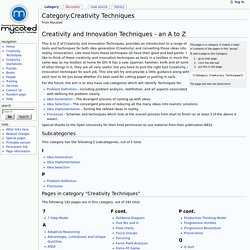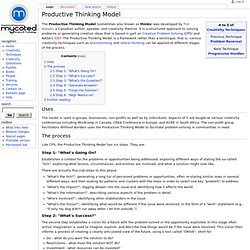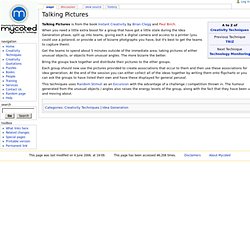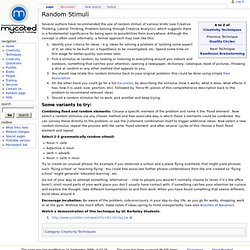

爭鳴動向網站. 主啊! 我真愛你. International House of Prayer. Vocabulary.com - Learn Words - English Dictionary. Spelling & Vocabulary Website: SpellingCity. Category:Creativity Techniques. This A to Z of Creativity and Innovation Techniques, provides an introduction to a range of tools and techniques for both idea generation (Creativity) and converting those ideas into reality (Innovation).

Like most tools these techniques all have their good and bad points. I like to think of these creativity and innovation techniques as tools in a toolbox in much the same way as my toolbox at home for DIY. It has a saw, spanner, hammer, knife and all sorts of other things in it, they are all very useful, but you have to pick the right tool (creativity / Innovation technique) for each job. This site will try and provide a little guidance along with each tool to let you know whether it's best used for cutting paper or putting in nails. Productive Thinking Model.
From Mycoted The Productive Thinking Model (sometimes also known as thinkx) was developed by Tim Hurson, a Canadian author, speaker, and creativity theorist.

It is a structured approach to solving problems or generating creative ideas that is based in part on Creative Problem Solving (CPS) and NASA's IDEF. The Productive Thinking Model is a framework rather than a technique; that is, various creativity techniques such as brainstorming and lateral thinking can be applied at different stages of the process. Uses The model is used in groups, businesses, non-profits as well as by individuals. The process Like CPS, the Productive Thinking Model has six steps. Step 1: "What's Going On? Establishes a context for the problems or opportunities being addressed, exploring different ways of stating the so-called "itch", exploring what factors, circumstances, and entities are involved, and what a solution might look like. There are actually five sub-steps to this phase: "What's the Itch? " Further reading. Bodystorming. Think Tank. Kepner and Tregoe method. From Mycoted This technique emphasises the ‘rational’ rather than the ‘creative’, it is essentially a method for fault diagnosis and repair rather than for disorganized or systemic problem domains, or those where freshness of vision is essential.

Kepner and Tregoe (1981) describe the method below, but its origins date from the 1950’s. The method is fully developed, with recommended techniques, worksheets, training programme's, etc. The headings below provide a bare outline and it follows two main stages, each has seven steps: Problem Analysis You should know what ought be happening and what is happening, this can then be expressed as a deviation, comparing them and recognising a difference that seems important to you.
Decision-Making. Pictures as Idea Triggers. Talking Pictures. From Mycoted Talking Pictures is from the book Instant Creativity by Brian Clegg and Paul Birch.

When you need a little extra boost for a group that have got a little stale during the Idea Generation phase, split up into teams, giving each a digital camera and access to a printer (you could use a polaroid, or provide a set of bizarre photgraphs you have, but it's best to get the teams to capture them). Get the teams to spend about 5 minutes outside of the immediate area, taking pictures of either unusual objects, or objects from unusual angles. The more bizarre the better. Bring the groups back together and distribute their pictures to the other groups. Each group should now use the pictures provided to create associations that occur to them and then use these associations for idea generation. This techniques uses Random Stimuli as an Excursion with the advantage of a challenge / competition thrown in. Visual Brainstorming.
Spirit Of Photography (Post 1 Award 5) - Comment or be banned 分享區. Criteria for idea-finding potential. From Mycoted The focus and content of a problem statement can be adjusted and developed in a variety of ways.

However after the development stage it is valuable to ensure that the way it is expressed will support the workings of the problem solving method you are using. Isakesen, Dorval and Treffinger (1994) developed this straightforward checklist, which is supportive of this procedure Does it show the way to lots of ideas? Is it the question about which you want to find ideas? If the statement appears to falter on any criteria, perhaps you can modify it to reinforce its effectiveness for gathering ideas. (See also the CATWOE criteria) Random Stimuli. From Mycoted Several authors have recommended the use of random stimuli of various kinds (see Creative Thinking, Lateral Thinking, Problem-Solving through Creative Analysis), which suggests there is a fundamental significance for being open to possibilities from everywhere.

Although the concept is often used informally, a formal approach may look like this: Identify your criteria for ideas – e.g. ideas for solving a problem or tackling some aspect of it, an idea to be built on, a hypothesis to be investigated, etc. Spend some time on this stage for better-quality outcomes later. Random Stimuli. MyTools. 網上時鐘(Flash) Dropbox - Simplify your life.
NTPClock 時鐘校對. Www.stdtime.gov.tw/chinese/bulletin/NTP promo.txt. Welcome to Full Gospel Television. Welcome to FGTV.